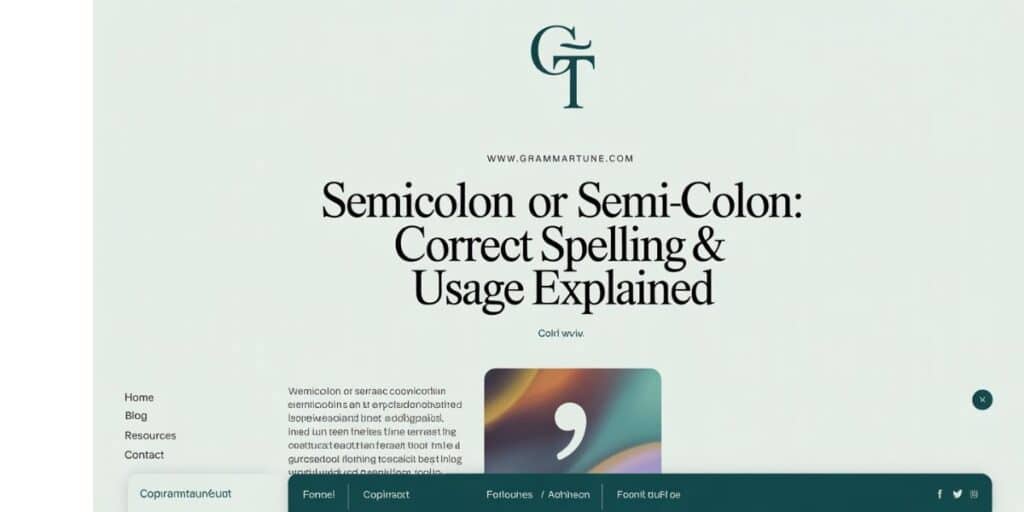Still confused about ”semicolon” or ”semi colon”? Don’t worry; you’re not the only one. Here is a fast guide to its correct spelling, smart use, and all grammar mishaps cleared up once and for all.
🔹 Introduction & Spelling Confusion
What is a Semicolon?
A semicolon (;) is a punctuation mark that links ideas. It stands between a period and a comma in strength. It shows a close connection between two independent thoughts.
Must read: Vicious vs Viscous: Use Them Correctly in Writing
Why is There Confusion?
People mix it up with colons or commas because they look similar. Plus, the rules aren’t always taught clearly.It makes people a little perplexed as to when and how to use them.
“Semicolon” or “Semi-Colon:” The Correct Spelling
The correct modern spelling is “semicolon”; it isn’t hyphenated. Though both versions exist, one is now favored. The hyphenated form feels a bit outdated.
The Preferred Spelling: “Semicolon”
Writers, editors, and teachers mostly prefer semicolon. It’s cleaner and matches other compound words. Simpler forms tend to stick in usage.
Why “Semi-Colon” is Outdated
“Semi-colon” was more common in older texts. But spelling trends evolve over time. Today, it’s considered old-fashioned and less professional.
Etymology of “Semicolon”
The name stems from Greek, where “semi” means half and “colon” stands for a sentence. It literally means half a colon, showing its grammar role. The name fits its function well.
✍️ How & When to Use a Semicolon
When to Use a Semicolon
Use a semicolon when two complete sentences relate closely. It connects them without a conjunction. Think of it as a soft stop.
Connecting Related Independent Clauses
Semicolons join two independent clauses that could stand alone. Example: “I love coffee; it keeps me awake.” This shows how the ideas relate.
Clarifying Complex Lists
Items that are in brackets along with the comma, as in, “We visited Paris, France; Berlin, Germany; and Rome, Italy,” avoid confusion. But, semicolons are required in such cases.
Linking Clauses with Transitional Phrases
Semicolons precede transition phrases like however or therefore; e.g. Therefore=””She was tired; however, she kept going. It helps to smooth the sentence.”.
Avoiding Run-On Sentences
Instead of cramming two full thoughts with just a comma, use a semicolon. This prevents comma splices. It keeps your writing grammatically sound.
You will like: What’s the Plural of Hippopotamus? Is it Hippopotamuses?
When Not to Use a Semicolon
Don’t use one if the second part isn’t a full sentence. Avoid placing it between an independent and a dependent clause. That breaks the rule.
📘 Practical Usage Rules
How to Use a Semicolon
Put a semicolon to show relation without the words “and” or “but;” it supplies variety to your writing and also maintains sudden cleanness.
Use Semicolons to Connect Related Independent Clauses
Exemplify: “The program was a success; everyone had a standing ovation.” A semicolon links two strong statements, each of which cannot exist in isolation.
Use Semicolons Instead of Coordinating Conjunctions
Sometimes a semicolon is used instead of “and” or “but.” This prevents repetition and makes your writing crisper.
Use Semicolons with Conjunctive Adverbs
Conjunctive adverbs like “therefore,” “meanwhile,” or “moreover” always need semicolons in front of them. For example: “He was late; nevertheless, he finished first.”
Use Semicolons in a Serial List
Semicolons help when items in a list already contain commas. This separates each clearly. It keeps your meaning from getting lost.
⚖️ Semicolon vs. Other Punctuation
Period vs. Semicolon
A period ends a thought completely. A semicolon links ideas without that hard stop. It keeps the flow going.
Colon vs. Semicolon
Use a colon to introduce or explain something. A semicolon connects ideas. They serve different purposes.
Capital Letters After Semicolons
Don’t capitalize after a semicolon unless it’s a proper noun. It doesn’t start a new sentence. The second part continues the thought.
You will like: Coach vs Couch: Definitions, Differences, and Examples
FAQ’S
Can a semicolon replace a comma?
No, a semicolon can’t replace a comma unless the sentence has internal commas and needs clearer separation. Otherwise, commas and semicolons serve different roles.
Is it wrong to use a semicolon before “and” or “but”?
Yes, generally avoid it. If you’re using “and” or “but,” stick with a comma. Use a semicolon only when those conjunctions are removed.
Can I use a semicolon in dialogue?
Yes, but sparingly. In casual speech, semicolons may feel too formal. Use them only if the dialogue has two full, related statements.
Are semicolons still necessary in modern writing?
Absolutely. While informal writing leans on shorter sentences, semicolons enhance clarity and style in formal or academic work.
What’s the most common mistake with semicolons?
Using them between a complete sentence and a fragment. Both sides of a semicolon must be independent clauses.
Conclusion
Understanding the difference between semicolon and semi-colon matters in writing. While both spellings exist, semicolon is now the standard.That is when one knows the correct use of its fruition: to bring clarity, rhythm, and polish a sentence.
It’s a semicolon that might link related thoughts or bundled thoughts in an organized but preferably messy list; a silent ally. So next time you hesitate, remember: this tiny mark can say a lot—without saying too much.

Joulia, a seasoned wordsmith and grammar enthusiast, brings over a decade of blogging expertise to Grammar Tune. With a keen eye for linguistic precision and a passion for making complex grammar concepts accessible, he has helped thousands of readers enhance their writing skills. His engaging teaching style and practical approach to language learning have made him a trusted voice in the online grammar community.







